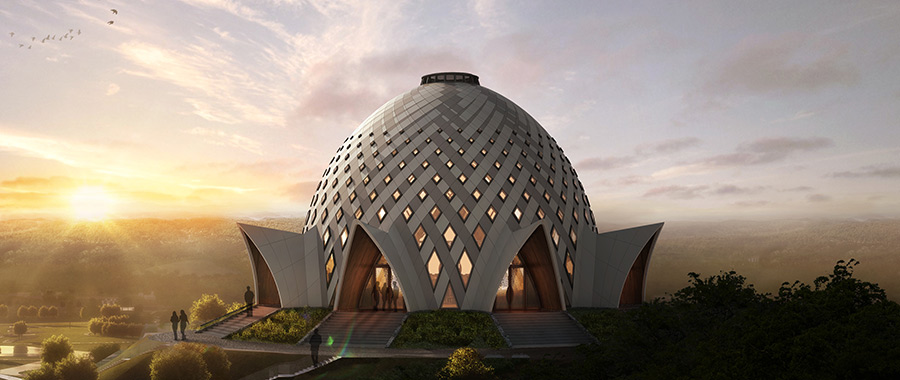The Baha’i Faith is a religion that emphasizes the unity of humanity, encapsulated beautifully in its architectural endeavors. One striking embodiment of this principle is the Baha’i Temple located in Papua New Guinea, often referred to as the “Weaving Designs of Unity.” The temple not only serves as a place of worship but also as a beacon for the ideals of the Baha’i teachings, showcasing a profound amalgamation of spirituality, artistry, and cultural expression.
This article explores the intricate layers and thematic elements that the Papua New Guinea Baha’i Temple brings to the forefront. Readers can expect a comprehensive examination of the architectural design, the significance of unity within the Baha’i teachings, cultural dialogues reflected in the temple’s aesthetics, and an interpretation of its role in fostering community engagement and spiritual development.
1. Architectural Design and Symbolism
At first glance, the architectural design of the Papua New Guinea Baha’i Temple is an emblem of complexity intertwined with simplicity. Its structure, characterized by a series of interwoven elements, symbolizes the core tenet of unity in diversity. The harmonious curves and layered facets echo the Baha’i belief that different cultures, religions, and races can coalesce to form a beautiful and coherent whole.
The blueprint of the temple resonates with the natural surroundings, using locally sourced materials that tie the edifice to its geographical context. This approach not only showcases environmental stewardship but also enhances communal accessibility, inviting local inhabitants to engage with architectural beauty that reflects their own cultural narratives. The use of natural light within the temple’s design serves to create an illuminating atmosphere conducive to reflection and meditation, reinforcing the idea of divine presence manifesting through unity.
2. Theological Underpinnings of Unity
Central to the Baha’i Faith is the principle of unity—that humanity, despite superficial distinctions, is fundamentally interconnected. This philosophy is vivid in the teachings of Baha’u’llah, the founder of the Baha’i Faith, who articulated that the dawn of a new era for humanity hinges on the recognition of this intrinsic oneness. The temple stands as a testament to this belief, representing not merely a physical structure but a spiritual framework encouraging mutual respect and understanding among diverse groups.
Within the temple, devotional gatherings take place that embody these principles. Individuals from various backgrounds unite to worship, pray, and reflect on Baha’i texts that extol the virtues of unity, peace, and love. Such gatherings serve not only as spiritual nourishment but also as a catalyst for broader dialogues on social issues that transcend cultural barriers, thereby fostering a sense of belonging within the global community.
3. Cultural Reflections and Artistic Expression
The temple is adorned with motifs and decorations that channel the rich tapestry of Papua New Guinean culture. Artistic elements, elegantly interwoven throughout the structure, encapsulate local traditions while embracing a universal aesthetic. The incorporation of traditional symbols serves to honor the indigenous peoples and their art forms, emphasizing that the Baha’i Faith does not seek to supplant cultural identities but rather to promote an all-encompassing unity that acknowledges and celebrates diversity.
Artisans from various ethnic groups contributed to the temple’s design, resulting in a collaborative testimony to unity in diversity. This initiative not only galvanized local talent but also forged relationships among communities that might otherwise have remained isolated. The artistic engagement extends beyond the temple’s walls, as cultural programs and exhibitions organized around the temple’s mission serve to enrich community ties and encourage creative collectivism.
4. Community Engagement and Spiritual Development
The Baha’i Temple in Papua New Guinea is much more than a sanctuary for worship; it acts as a vibrant hub for community engagement and educational opportunities. Within its precincts, visitors and locals can participate in a plethora of activities ranging from devotional gatherings to educational workshops that delve into the teachings of the Baha’i Faith.
Classes designed for both adults and youth emphasize moral education, personal development, and social responsibility—key tenets that align with Baha’i principles. Through these programs, participants are encouraged to cultivate virtues such as compassion, integrity, and justice, thereby nurturing a spiritually vibrant community dedicated to collective advancement.
The temple also spearheads interfaith dialogues that invite diverse faith communities to share their beliefs and practices. This initiative fosters an atmosphere of mutual respect and understanding, which is essential for cultivating harmony in a world often fraught with discord.
5. Conclusion: A Global Symbol of Unity
The Baha’i Temple in Papua New Guinea is a powerful manifestation of the Baha’i teachings on unity, serving as a dynamic confluence of spirituality, culture, and community. Its architectural beauty reflects the profound lessons of interdependence inherent in the Baha’i Faith, while the activities and discussions it hosts promote an environment where diversity is celebrated and nurtured.
As we navigate the complexities of our contemporary world, the temple stands as a reminder that through embracing our shared humanity, we can foster understanding and harmony across the globe. In essence, it invites us all to partake in the beautiful tapestry of creation, urging us to weave designs of unity that transcend the confines of our individual identities.
